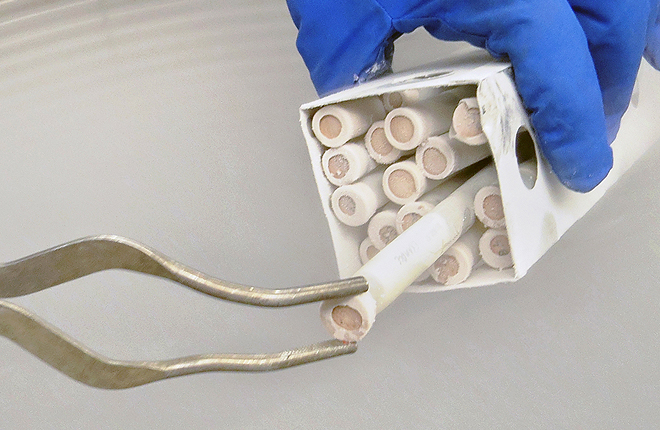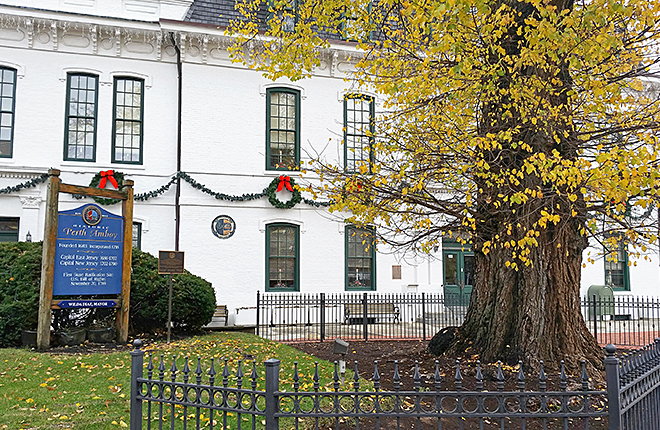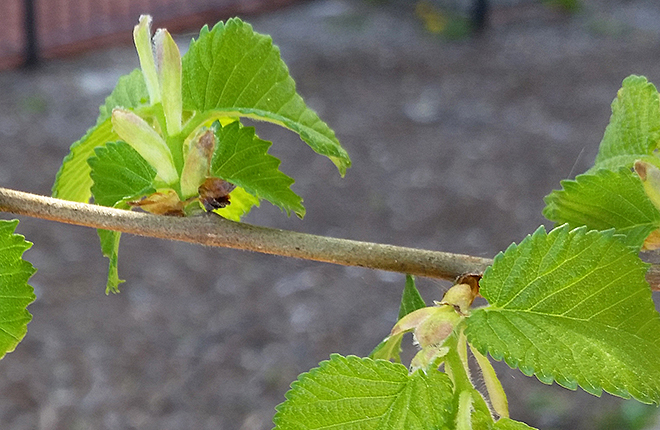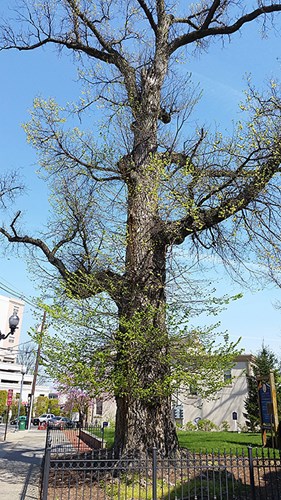ARS Helps Preserve Historical Elm Tree
|
|
A weathered old elm tree stands in front of the City Hall building in Perth Amboy, New Jersey. From that vantage point, it’s seen more than 200 years of American history. Throughout those centuries, it has withstood bouts of Dutch elm disease and poundings from brutal storms like 2012’s Hurricane Sandy.
This winter, researchers will take a high-tech approach to ensuring the genetic heritage of that elm tree. Under an agreement with the New Jersey Department of Environmental Protection (NJDEP), scientists with the Agricultural Research Service (ARS) will cryopreserve twigs cut from the aging tree’s branches—in essence, storing them in a flash-frozen state for decades and quite possibly, centuries.
The original plan was to cryopreserve the elm’s seeds, notes Christina Walters, a plant physiologist with ARS’s National Laboratory for Genetic Resources Preservation in Fort Collins, Colorado. However, there were no embryos within the seeds—probably because there were no other elms nearby to pollinate the flowers on the old elm tree.
Walters e-mailed the bad news to the NJDEP contact who had shipped the seeds to her.
“Because elm trees are rare and increasingly become susceptible to Dutch elm disease as they reach sexual maturity, the lack of a pollen donor isn’t too surprising,” she wrote. “I think this provides further testament [to] the rareness of your tree and how special it is.” (See “Dutch Elm Disease Update,” June 2006.)
The elm was planted around 1815 and today is considered a symbol of the coastal town’s strength and ties to both New Jersey’s and our nation’s history. For example, on March 31, 1870, town resident Thomas Mundy Peterson (a.k.a. Thomas Henry Peterson) walked beneath the tree on his way into City Hall, where he became the first African American to vote under the then-newly enacted 15th Amendment.
|
|
The NJDEP representative who contacted Walters last April had done so hoping something could be done to preserve the genetic and historical legacy of the elm—before its advanced age made it too hazardous to remain standing.
The discovery that the tree’s seeds weren’t viable was disappointing. Fortunately, Walters’s team had successfully cryopreserved all kinds of germplasm from apple, ash, maple, willow, oak, walnut, chestnut, and citrus tree species. The germplasm includes seeds, pollen, excised embryos, twig cuttings, and shoot tips. In one example, the researchers adapted a procedure called “cryotherapy” to preserve the shoot tips of 150 citrus cultivars while at the same time clearing pathogens from the material. This ensured pathogen-free material for use in research, breeding, and commercial operations. (See “Storage Technique Preserves Citrus, Kills Pathogens,” July 2013.)
Although cryopreserving elm twig cuttings hadn’t been attempted before, Walters’ team decided to give it a try. This winter, when the temperatures drop to their lowest, a NJDEP crew will snip twigs from the elm and ship them to Fort Collins, where the researchers will cryopreserve them using methods tried with other tree species. In the spring, they’ll also explore approaches to obtaining viable seed from the elm, using pollen collected from the tree or taken from another elm of the same species, once one is found.
To Walters, meeting the technical challenge of cryopreserving the elm is crucial to the laboratory’s overarching mission, which is to safeguard not only important plant genetic resources, but also those of animals and microorganisms.
“Our beautiful elm trees were decimated by the introduced fungal pathogen that causes Dutch elm disease,” she says. “This kind of thing happens all the time in agriculture. Using our genetic resource collections, we can stay steps ahead of such disasters—whether they happen to elms, apples, citrus, or wheat.”—By Jan Suszkiw, ARS Office of Communications.
Key Facts
- Dutch elm disease has killed millions of American elm trees.
- A surviving but frail elm in New Jersey is more than 200 years old.
- ARS experts will try to cryopreserve germplasm from the tree.
Full Story












